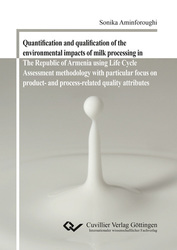| Departments | |
|---|---|
| Book Series (96) |
1378
|
| Nachhaltigkeit |
3
|
| Gesundheitswesen |
1
|
| Humanities |
2364
|
| Natural Sciences |
5406
|
| Mathematics | 229 |
| Informatics | 319 |
| Physics | 980 |
| Chemistry | 1363 |
| Geosciences | 131 |
| Human medicine | 243 |
| Stomatology | 10 |
| Veterinary medicine | 108 |
| Pharmacy | 147 |
| Biology | 835 |
| Biochemistry, molecular biology, gene technology | 121 |
| Biophysics | 25 |
| Domestic and nutritional science | 45 |
| Agricultural science | 1004 |
| Forest science | 201 |
| Horticultural science | 20 |
| Environmental research, ecology and landscape conservation | 148 |
| Engineering |
1793
|
| Common |
98
|
|
Leitlinien Unfallchirurgie
5. Auflage bestellen |
|
Advanced Search
Quantification and qualification of the environmental impacts of milk processing in The Republic of Armenia using Life Cycle Assessment methodology with particular focus on product- and process-related quality attributes (English shop)
Sonika Aminforoughi (Author)Preview
Preface, PDF (55 KB)
Table of Contents, PDF (86 KB)
Extract, PDF (180 KB)
Environmental Life Cycle Assessment (ELCA) is a young, but, increasingly a well-known technique, to assess the environmental impacts associated with products. In this dissertation thesis, a product-/process-related ELCA for a typical Armenian dairy factory has been performed. Here, the environmental impacts associated with the manufacturing processes of selected dairy products have been investigated. The production of raw milk at the supplier dairy farm and the disposal of the solid waste and waste water incurred during production and processing have been considered as well. Due to the multi-functional nature of dairy factories, an allocation procedure according to the calorific value of each product under assessment has been conducted. In order to execute the ELCA, the software SimaPro has been used. As the methodology for Life Cycle Impact Assessment, the ReCiPe Midpoint method has been applied. Inventory, characterization, normalization, contribution, and sensitivity analyses have been carried out accordingly. The results of these analyses have determined the significant impact categories by each analyzed product and the products with the greatest environmental impacts. Furthermore, the “hotspots” of the processes have been determined.
Ökologische Lebenszyklusanalyse (Ökobilanz) ist eine junge, jedoch inzwischen eine gut bekannte Methode zur Untersuchung der Umweltauswirkungen der Produkte. Im Rahmen dieser Dissertation wurde eine produkt-/prozessbezogene Lebenszyklusanalyse für eine typische armenische Molkerei durchgeführt. Hierbei wurden die Umweltauswirkungen der Herstellungsprozesse ausgewählter Molkereiprodukte untersucht. Die Rohmilchproduktion in der Lieferfarm und die Entsorgung der anfallenden Produktionsabfälle und –abwässer wurden gleichfalls betrachtet. Wegen der multifunktionalen Natur der Molkereien wurde ein Allokationsverfahren basierend auf dem Brennwert jedes untersuchten Produktes durchgeführt. Um die ökologische Lebenszyklusanalyse durchzuführen, wurde die Software SimaPro verwendet. Die Methode ReCiPe Midpoint wurde als Methode der Wirkungsabschätzung verwendet. Dementsprechend wurden Inventory-, Wirkungsabschätzungs-, Normalisierungs-, Beitrags- und Sensitivitätsanalysen durchgeführt. Ergebnisse dieser Analysen haben die signifikanten Umweltkategorien bei jedem untersuchten Produkt und die Produkte mit den höchsten Umweltauswirkungen identifiziert. Darüber hinaus wurden die „Hotspots“ der Prozesse festgestellt.
| ISBN-13 (Hard Copy) | 9783954049363 |
| ISBN-13 (eBook) | 9783736949362 |
| Final Book Format | A5 |
| Language | English |
| Page Number | 168 |
| Lamination of Cover | matt |
| Edition | 1. Aufl. |
| Publication Place | Göttingen |
| Place of Dissertation | Kassel |
| Publication Date | 2015-03-06 |
| General Categorization | Dissertation |
| Departments |
Agricultural science
|
| Keywords | Environmental Life Cycle Assessment, LCA, Life Cycle Impact Assessment Emissions, Milk Industry, Process hot spots, Process optimization |








